Catamaran tour: Wadden Sea adventure - twelve Frisian islands with the Strandkat
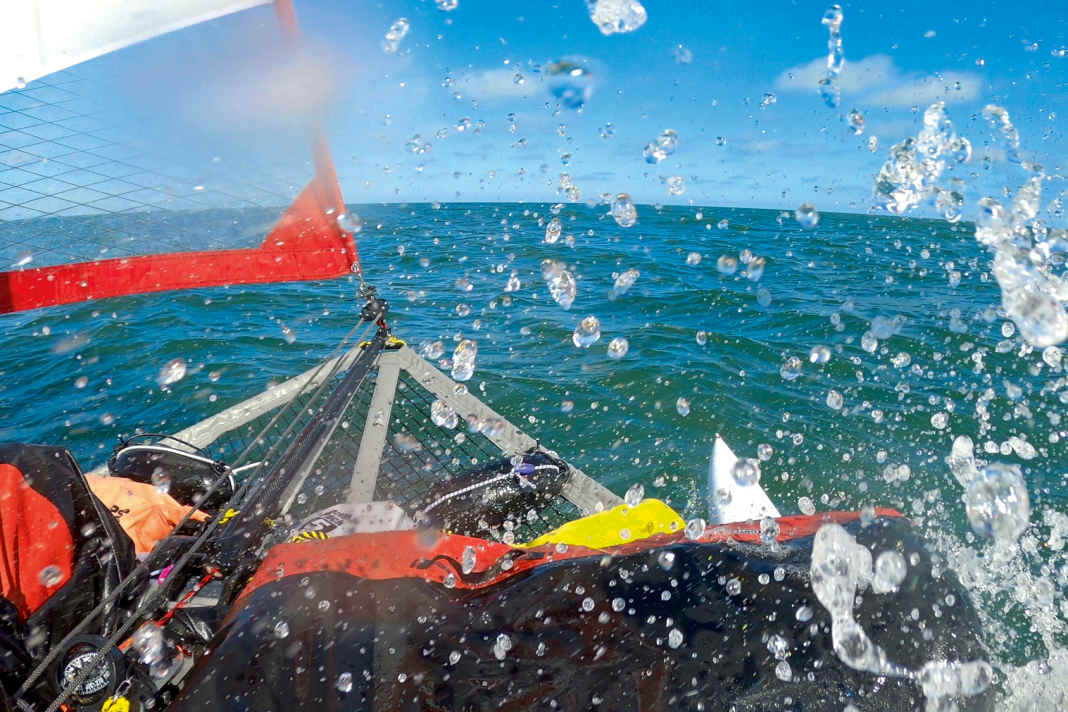





Michael Kujawa loves challenges on the water. "When I do something, I do it properly," says the 56-year-old music teacher from near Braunschweig. His most recent cruise destination was the islands along the German and Dutch North Sea coast. Not one, but all of them. The minimalist sailed from Texel to Wangerooge in three weeks on his five-metre XCat beach catamaran. In this interview, he explains how he experienced the cruise in the little speedster, why he doesn't need an engine and where the appeal and limits of this adventure lie.
YACHT: Mr Kujawa, you have been travelling with the small cat in an area that is known for its pitfalls. Did you really get hit on the head during the three weeks?
Michael Kujawa: No, but I was also very lucky with the weather, it was fantastic: sunny, warm, good wind strength - but the direction was completely wrong.
That means?
The weather wasn't what you always read about. The wind was actually predominantly westerly - I never had that! But it was almost constantly north-easterly. That's why I had to cross a lot. Before Schiermonnikoog, I thought about simply turning round and sailing back to Den Helder!
You didn't do that - because you had a fixed idea in your head?
Yes, I wanted to spend at least one night on each island. If in doubt, I could have broken off at any time and travelled from any port to Den Helder by public transport and picked up my car. But it worked out, I arrived in Harlesiel on the last day as planned.
Good seamanship is the be-all and end-all in the Wadden region. How did you plan the stages?
Depending on the tide, I sometimes sailed around the outside of the islands, sometimes inside across the Wadden Sea. My cat doesn't have a draught, which makes it ideal for sailing across the mudflats. But the West Frisian Islands in particular are so incredibly long and sometimes have several high tidal flats that you have to make it through them all in one tide. That's why I deliberately sailed some stages on the North Sea. I love that. It's very, very beautiful there.
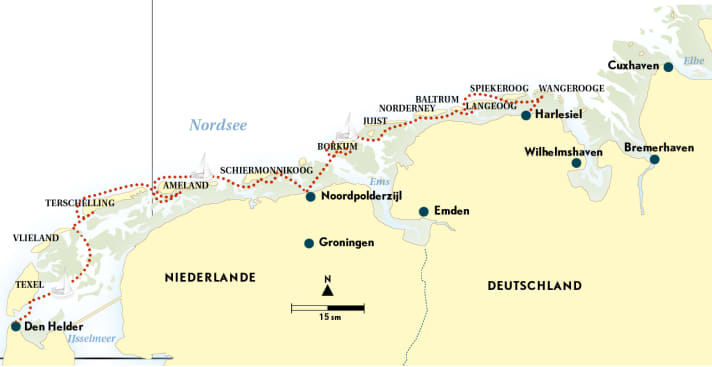
Almost every unusual trip has a backstory. This one too?
I'm actually a sea kayaker, know the area a bit and have already paddled to Helgoland. That's where I learnt about the tides. So I wasn't a total greenhorn. When I was kayaking, I always admired the sailors and eventually bought an LM32. Unfortunately, my wife didn't like sailing, so I sold the boat after two years. But the dream of sailing around all the West and East Frisian Islands was still there. I came across the XCat catamaran by chance and bought it a good year ago. The flexibility is brilliant: in winter it hangs under the ceiling in the garage, and I can stow it in bags for transport on the car roof.
Was this North Sea cruise your first with the catamaran?
No, I started out on Lake Schwerin and Lake Müritz. This was followed by day trips in the Croatian Kornati islands. That was my first time at sea. I sailed my first trip with luggage and a tent in the Danish South Sea, with up to 7 Beaufort and plenty of waves!
How does cruising on the Strandkat work? Where do you stay overnight?
Basically, I wanted to be in the harbour at night, but I also wanted to spend the night in the mudflats! On Schiermonnikoog, the time had come: I was sent away with the statement that the harbour was full. I said to myself: "Think positive", left the harbour again, went around the corner and fell dry there. I liked it so much that I spent a second night at the same spot and then another one later at the eastern end of the island. I was all alone there - beautiful!
How did people in the harbours react to you?
Except for this one experience, it was always positive! I was the attraction. It looks funny to see a little one lying amongst all the big ones. It was nice that people were very impressed throughout. I've never chatted so much on holiday before. There were always questions about how it works, how I do it, where I sleep.
And where did you sleep?
I had a simple, cheap tent with me, which I set up as a cabin on the cat in the evening. I had tried it out in the garden beforehand to see if it would work. The method worked and now I've bought a very good, high-quality tent.
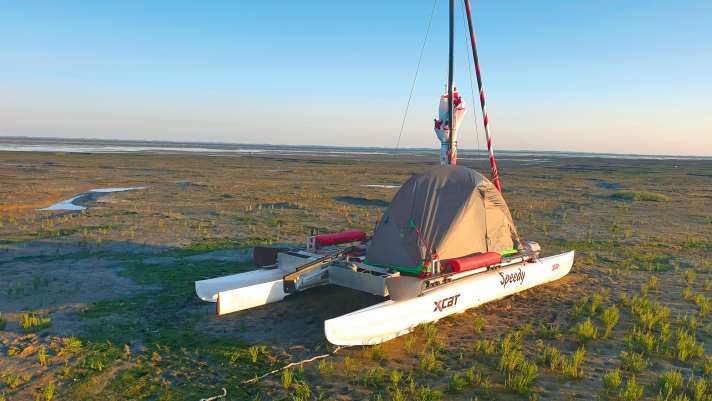
But with three weeks of rainy weather, the fun would probably have suffered too!
For sure! I would have cancelled the tour if it had been raining for a week. I don't have to prove anything to anyone.
How did the port manoeuvres go?
I had respect for the harbour entrances, where the current often crosses. I was usually able to sail in with a lot of momentum - a few times right up to the jetty. Once you're in, you've won. If I had to, I would have sailed past it, first of all I would have sailed onto the beach somewhere and waited for slack water. I often took the sails down in the entrance and continued with the paddle.
And then right into a mooring box, like with a big boat?
First I moored where there was room, then I asked the harbour master. There was always a place somewhere, either in a proper box or alongside. I had attached four extra cleats for mooring lines before the trip. But I would also have slipped the boat out overnight.
I had respect for the harbour entrances, where the current often crosses. But most of the time I was able to sail in with momentum"
Cooking, eating, washing: How did your harbour life go?
Comfortable! In the harbours I had access to the sanitary facilities that every other sailor has. I usually cooked on the jetty with my storm cooker. If there was a nice bench somewhere, I went there with my rucksack.
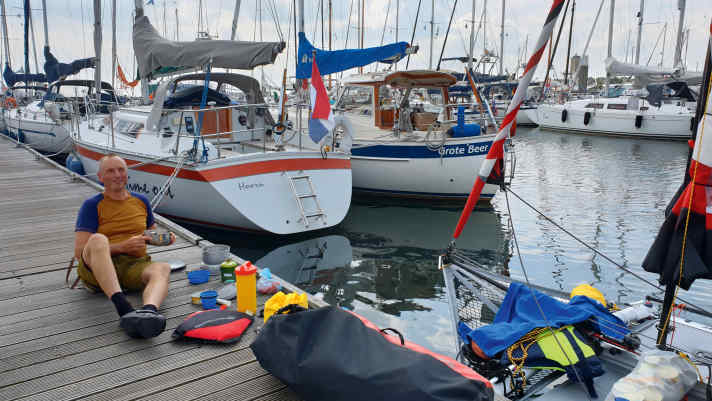
What was on your menu plan?
Mostly pasta in the harbour. Or outdoor dishes that you only have to add water to. But sometimes there was also a nice steak. Incidentally, I had far too many provisions with me! I was still used to not being able to shop anywhere from my paddling tours with overnight stays in the wilderness.
How much attention do you pay to the weight of your equipment?
Very much! I have a spork, for example. Do you know what that is?
Yes, fork and spoon in one!
Exactly. Mine is made of titanium and has a small saw on one side. The fewer items you take with you, the better. I still have a pocket knife with me. I try to use every item several times. For example, my paddle has a handle in the paddle blade so that I can also use it to unfurl the foresail. And the two discs of the anchor ball are great to use as a chopping board when cooking!
How do you stow it all?
I had luggage bags and smaller labelled bags inside so that you could find your sleeping bag, socks, toothpaste and so on. There are no lockers or cupboards. If you have to start rummaging through everything, it's no fun.
Where do you leave the bags?
At first I had everything in the front of the luggage net. That was a disaster. I dived far too deep into the waves and was afraid it wouldn't hold. My main luggage is now at the end of the trampoline, directly in front of the luggage net, where only light items are stored. In the harbour, I put the two large black luggage bags on the jetty - on the boat, I need the space for the tent. People live very publicly, and I try to put the bags down as inconspicuously as possible and not block the whole jetty. Things like anchors and lines are stowed in two large metal boxes that a metal constructor made for the cat.
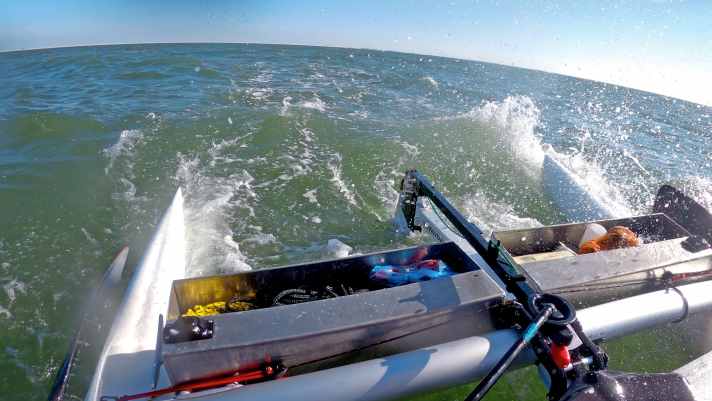
You are a guitar teacher. Was there a guitar on board?
No. I was happy just to be able to hear everything else. My fingers also suffer a lot on the tour. It always takes a while after these adventurous trips before I can play something adequately for my students again. I am therefore careful. But too much fear isn't good either.
Everything has to be tied to the boat very carefully. There is a great risk of something going overboard on the way"
Keyword fear: In what conditions would you no longer have sailed?
I always planned the next beat the evening before and thought carefully about what was OK and what was not. On the wadden side I would have gone out up to 6 Beaufort, on the seaward side up to 5. It was never risky, but you have to like it. Sometimes you're completely wet. And if you then have to navigate ...
Do you have paper or digital nautical charts with you?
Both! I'm a fan of paper maps. I also have a map-enabled handheld GPS device and a waterproof outdoor smartphone with maps from OpenSeaMap. I usually navigate with the latter because it's convenient and has a nice big display. However, the device gets nervous if too much water hits the catamaran, so the device with the buttons is better. The devices are mounted so that they are within easy reach, I can look at them and they don't go overboard. Everything has to be tied down. The risk of something going overboard is high.
How do you secure yourself?
When I realise that things are getting a bit more intense, I attach my handheld radio to my husband. I'm on a lifeline. I use a kind of bungee cord that can stretch. I'm worried that if I fall overboard at a speed of ten or twelve knots, the jolt would rip out a vertebra or something. The rope is long, so I can move everywhere. I'm very happy with this solution.
Have you ever tried the system - intentionally or unintentionally?
Yes, I jumped out at a speed of three to four knots to try it out. Climbing back onto the cat is not easy, but it works with the solid-fuel lifejacket I'm wearing. An automatic model with a cartridge, on the other hand, would always go off.
As your boat doesn't have an engine, you had to plan the stages particularly carefully. Did the plan to always have a push current work out, or did you also have to tack?
When I sailed round the outside, the sailing tactic was to sail to the north-west corner of an island with the outgoing water and then sail eastwards with the incoming water. This became difficult on the longest leg from Ameland to Schiermonnikoog. I sailed mostly against the current in order to arrive in daylight. Crossing again, of course! It took me twelve hours to cover 46 nautical miles. After that I was done.
That sounds like the most difficult blow. Was it?
Yes, and it was also the windiest day. The forecast was for four to five from the north-east, and in the end there were certainly five. There was quite a lot going on.
What does that mean on the catalytic converter?
The hulls crash into the wave and are gone for a moment. When the wave crashes against the trampoline and the luggage, it makes a huge splash and I'm soaked from top to bottom. It's rough, but I always feel safe. It's quite different when you have a half-wind and the cat accelerates strongly at 5 to 6 Beaufort. Then there is a risk of undercutting and driving a plug.
The catamaran combines everything I like so much: being in contact with the water. Sailing without distance to the sea. Getting wet!"
Have you ever regretted doing the tour on a boat without a motor?
No. However, it was difficult on the leg from the Dutch mainland to Borkum. I couldn't get high enough into the wind, and the current of the Ems pushed me out so hard that I didn't reach the harbour on the island. Any normal sailor would have lowered the sails and started the engine. But without an engine, you quickly become a plaything of the forces of nature. So I passed Borkum, just managed to reach the north-west tip and waited for the tide to turn. Then I was able to sail into the harbour with the rising water.
That means you anchored off the island?
No, I simply drove the cat onto the beach. However, there's a catch: once the water has gone, you're way up on the beach. The cat weighs a good 145 kilograms with its luggage and is too heavy to move. So every five minutes I pulled it back towards the water - for four hours. Then the tide was low and I was able to sail towards the harbour with the rising water.
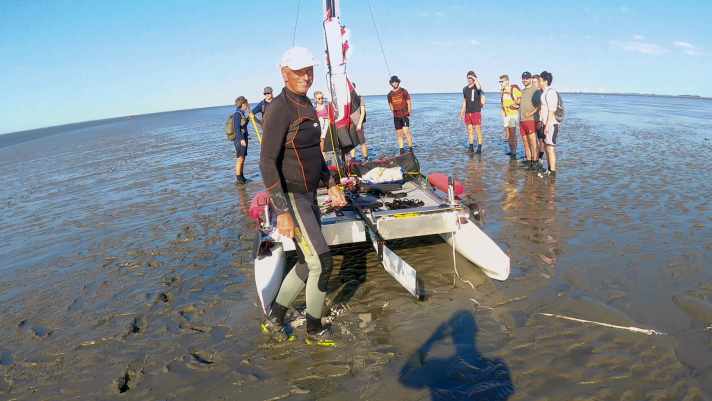
What would you have done if you had missed the island?
I calculated this beforehand and hoped that I would at least get to the north-west beach. If that hadn't happened - uff! Well, I would have arrived somewhere at the end of the island and saved myself on the beach. Once I tried to cross against the current. That cost me some height and I quickly abandoned it. In the end, it turned out the way I had planned for the worst-case scenario.
Things are gentler on the inland side of the islands. Did you keep to the mudflats there at all?
Rarely. I don't need that because I don't have a draught. On the first trip from Texel to Vlieland, I still travelled the mudflats. Later, from Juist to Norderney, I simply sailed out of the harbour once, straight ahead, then made a U-turn and, bang, into the new harbour - that was great!
After this trip: Do you now like the area better under sail than in a kayak?
Sailing has got me hooked! The catamaran combines everything I like so much: being in contact with the water, sailing at water level. It splashes and you get wet! Experiencing the elements up close is simply great on such a small catamaran.
The German XCAT shipyard representative sportwerft.de has further information and tours on the subject Water hiking with a beach cat compiled!
Area tips: Sailing in the Wadden Sea
The trip in the Wadden Sea is wonderful when sailors know the special features of the area
Wind and weather
The prevailing wind direction is north-west to south-west, and it is often stormy in spring and autumn. Otherwise the weather is changeable, even in summer. Lots of wind is just as possible as calm. If there is more than 5 Beaufort, you should not sail between the islands - if in doubt, head for Heligoland or stay in the Wadden Sea.
Navigation
On the sea side of the islands, the large traffic separation zones must be observed. It is best to keep clear of them in the coastal traffic zone. The Wadden Sea (Waddenzee in Holland) is much more sheltered, but even here an unpleasant wave can build up when the wind blows against the current; the channels in the western part of the Waddenzee have enough water to be navigated even at low tide. Ideally, you should sail in such a way that the current runs with you and you pass a high tidal flat when the water is rising.
Sea mark
In spring, the mudflats are marked with pricks. There are buoys in the shipping lanes, which are also adapted to changing waterways during the season. Unlike in East Friesland, many mudflats in West Friesland are buoyed, not pricked. Navigation by sight and sea marks is important due to the changing sands and tidal flats.
Harbours
The island harbours have a good infrastructure. They are moored on floating jetties and often on short finger pontoons. It is best to have a centre spring ready. Where the island village is not directly at the harbour, it is a short walk away. Some islands have a railway that is also used by ferry passengers.
Boat
Boats with a draught of no more than 1.40 metres are well suited to the area. If you have more, you can get into most harbours at high tide and also across the Wadden High, but the time window is small. Then it makes more sense to sail round the outside. If you don't want to explore the area on your own keel, you can use the IJsselmeer as a starting point for a charter trip. There are many charter companies there, for example in Lemmer or Enkhuizen.
Equipment
The echo sounder is indispensable. Unlike a nautical chart, which is usually inaccurate as soon as it appears due to the constant changes in the area, the echo sounder shows the truth - it is the only way to precisely localise current shallows, sands and fairways. Good anchoring gear also helps, for example when waiting for the next high tide, falling dry or anchoring in a tidal inlet.
Nature conservation
The boundaries of the bird and seal sanctuaries are marked on the nautical charts. Anchoring and falling dry is regulated or completely prohibited there.
Falling dry
It is beautiful, but only for very calm weather. Suitable spots can be recognised on the map. They should offer protection against wind and waves, but also be reasonably flat. This is indicated by the height of the dry areas on the nautical charts (underlined numbers). However, it is best to ask people who know the area or follow the recommendations in the cruising guide. Be careful not to get stuck on a steep reef edge. As soon as the water is gone, the sea valves are out of order. So don't forget to have a bucket of water ready for your feet!
Information for the tidal cruise
Indispensable is a Tidal calendar of the BSH.
Helpful information included
- " Cruising guide North Sea coast 1 " by Jan Werner
- " Cruising guide Holland 2 " by Jan Werner
- As a supplement: " Sailing in tidal waters " by W. Krusekopf
- wattsegler.com
- wattenschipper.de

